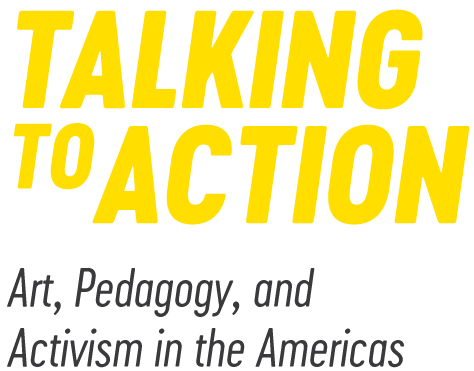ENGLISH:
Talking to Action: Art, Pedagogy, and Activism in the Americas is a collective effort to foreground the reciprocity of teaching and learning inherent in art making and to demonstrate ties between practices across distinct regions that bring together similar ways of working. Developing collaborative relationships with communities and other cultural workers, the artists featured in this exhibition not only investigate social and political concerns across the vast territory of the Americas, but also share a dialogical method of working that is foregrounded in the installations on view. The result of this ongoing research features drawings, sculptures, photography, video, film, and archival material that blur the lines between performative actions, object making, and political activism. They also reveal a distinctly decolonial perspective with regards to lived historical and contemporary sociopolitical contexts.
In the United States, the relatively new term of Social Practice is being used to define and professionalize a contemporary genre of art that has historical antecedents in an earlier generation of community-driven artists. Such an all-encompassing term does not exist in Latin America, though social-activist efforts have often been grounded in aesthetic commitments. Nevertheless, the important work of investigating and historicizing these practices across the Americas is ongoing.
The history of community-based art in Latin America is long and varied, but key events and thinkers emerge as signposts. These include the pedagogical theories of Paulo Freire, the closely aligned Liberation Theology movement of privileging the oppressed within the Catholic Church, and the large and decentralized post-war decolonial movements that guided social scientists to take on new research in efforts to better understand their hemisphere. Those interconnected methods were later influential on a wide range of cultural actors in the United States including Chicano and Feminist artists and intellectuals. Within this rich cultural history, the relationships connecting hemispheric efforts amongst artists and researchers across the Americas has yet to be closely considered.
The artworks in this exhibition are anchored in a dialogical praxis and a lineage of research. This legacy emerges from the southern part of our hemisphere and has a stake in how we understand art, pedagogy, and activism throughout the Americas.
– Bill Kelley Jr., Curator
ESPAÑOL:
Hablar y actuar: Arte, pedagogía y activismo en las Américas es un esfuerzo colectivo para poner en primer plano la reciprocidad de la enseñanza y el aprendizaje inherentes a la creación artística y demostrar vínculos entre las prácticas en diferentes regiones que reúnen modos similares de trabajo. Desarrollando relaciones de colaboración con las comunidades y otros trabajadores culturales, los artistas que figuran en esta exposición no sólo investigan las preocupaciones sociales y políticas en el vasto territorio de las Américas, sino que también comparten un método dialógico de trabajo que se destaca en las instalaciones que se muestran aquí. El resultado de esta investigación en curso muestra dibujos, esculturas, fotografía, vídeo, cine y materiales de archivo que borran los límites entre las acciones performativas, la creación de objetos y el activismo político. También revelan una perspectiva claramente descolonial con respecto a los contextos sociopolíticos vividos históricamente y en la contemporaneidad.
En los Estados Unidos, el término relativamente nuevo de Social Practice (práctica social) se utiliza para definir y profesionalizar un género de arte contemporáneo que tiene antecedentes históricos en una generación previa de artistas impulsados por la comunidad. No existe un término tan amplio en América Latina, a pesar de que los esfuerzos de activistas sociales se han basado a menudo en compromisos estéticos. Sin embargo, continúa el importante trabajo de investigar e historizar estas prácticas en las Américas.
La historia del arte comunitario en América Latina es larga y variada, pero eventos y pensadores surgen como marcadores claves. Estos incluyen las teorías pedagógicas de Paulo Freire, el movimiento alineado de Teología de la Liberación que busca privilegiar a los oprimidos dentro de la Iglesia católica, y los grandes y descentralizados movimientos descoloniales de posguerra que guiaron a los científicos sociales a emprender nuevas investigaciones para entender mejor su hemisferio. Esos métodos interconectados fueron más tarde influyentes en una amplia gama de actores culturales en los Estados Unidos, incluyendo artistas e intelectuales chicanos y feministas. Dentro de esta rica historia cultural, las relaciones que conectan los esfuerzos hemisféricos entre artistas e investigadores a través de las Américas aún no se han considerado detenidamente.
Las obras de arte en esta exposición están ancladas en una praxis dialógica y en un linaje de investigación. Este legado surge desde el sur de nuestro hemisferio y se destaca en cómo entendemos el arte, la pedagogía y el activismo en las Américas.
– Bill Kelley Jr., Curador


